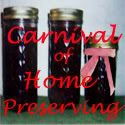Tomatoes were the very first thing I ever canned. Strawberry jam was second, and then I think a homemade version of Rotel was next. We use a fair amount of Rotel at our house so this was something I wanted to can for myself. Here's how I do it.
I start with my peppers. Give them a rinse and pat them dry.
I usually use green cayenne, but I've used other hot peppers too.
You could let the peppers get red, but I like the color contrast of the red and green.
I actually used nearly twice as many as are pictured here for the eight pints I canned that day.
Cut off the ends, split lengthwise down the pepper and then, using a very small, metal measuring spoon, scrape out the seeds and membranes. Unless you like your tomatoes and chilies very hot, then, by all means, leave them in. We like it on the mild to medium side.
Oh - and be sure to wear gloves during this part. You don't want all that capsaicin getting into your skin. It will burn your fingers and doesn't just come off when you wash your hands.
Chop them pretty small.
While I was working on the peppers, Kay, Bree and Beenie were peeling and chopping the tomatoes. I thought I had a picture somewhere of how we do this, but I couldn't find it. We cut a small x in the blossom end of each tomato and dip several at a time in boiling water. In just a minute or two, the skin will split and you can pull them out of the pot and quickly place them in ice water to cool them down. The skin will slide right off and then you can dice them.
Now we need to get the canner and jars ready.
While the canner and jars are heating, set a small pot of water on to boil (for your lids), another for topping off the jars, and get your work area ready. My kettle of boiling water is off to the side in this shot. You'll need your tomatoes, peppers, lemon juice, salt, lids, rings, pot of water for the lids, kettle of water for the jars, funnel, magnetic lid wand, a wash cloth and a few measuring spoons - a tablespoon, teaspoon, and 1/2 teaspoon. You'll also need something to get out air bubbles, and I like this little tool (right beside the lid wand) that has cuts in it to show headspace allowances. I assemble everything on a cutting board or towel because my counters tops are granite. If I put hot jars directly on my counter tops, the cold stone will cause the jars to break.
As soon as the small pot comes to a boil, pull it off to a trivet beside your work area and get your lids put in.
Using a slotted spoon to strain off excess juice, put a few tomatoes in the jar. Then add a tablespoon of lemon juice (for a pint - use 2Tbls for a quart). I put a spoon of room temperature tomatoes in first so the lemon juice, which has usually been in the fridge, won't crack the jar. Then fill the jar halfway with tomatoes, pressing them down, and add 2, very heaping teaspoons of the peppers.
Finish filling the jar to the neck with tomatoes, pressing them down, then pour in your boiling water, leaving 1/2" headspace. Finally, add 1/2tsp salt (for a pint - use 1tsp for a quart).
Wipe your rims, checking for any chips, put on your lid, screw the ring on finger tight and put them in the canner. I like to let them sit above the simmering water for a few minutes before I lower them in. It helps to keep the jars from breaking once they're in the pot. I have had jar casualties before, and this helps prevent that.
You'll process these for 40 minutes (for pints - 45 min. for quarts), once the canner has reached a full boil, with steam escaping from under the lid.
Remove them to a towel to cool overnight.
The next morning, remove the rings and check the seal. You may need to wipe the outside of the jar before storing these.
Some of our favorite ways to use these are in chili, and our cheese dip.
I've linked this post with the Carnival of Home Preserving. Stop by and check her out.
I've also linked up with the Homestead Bar Hop.
















































